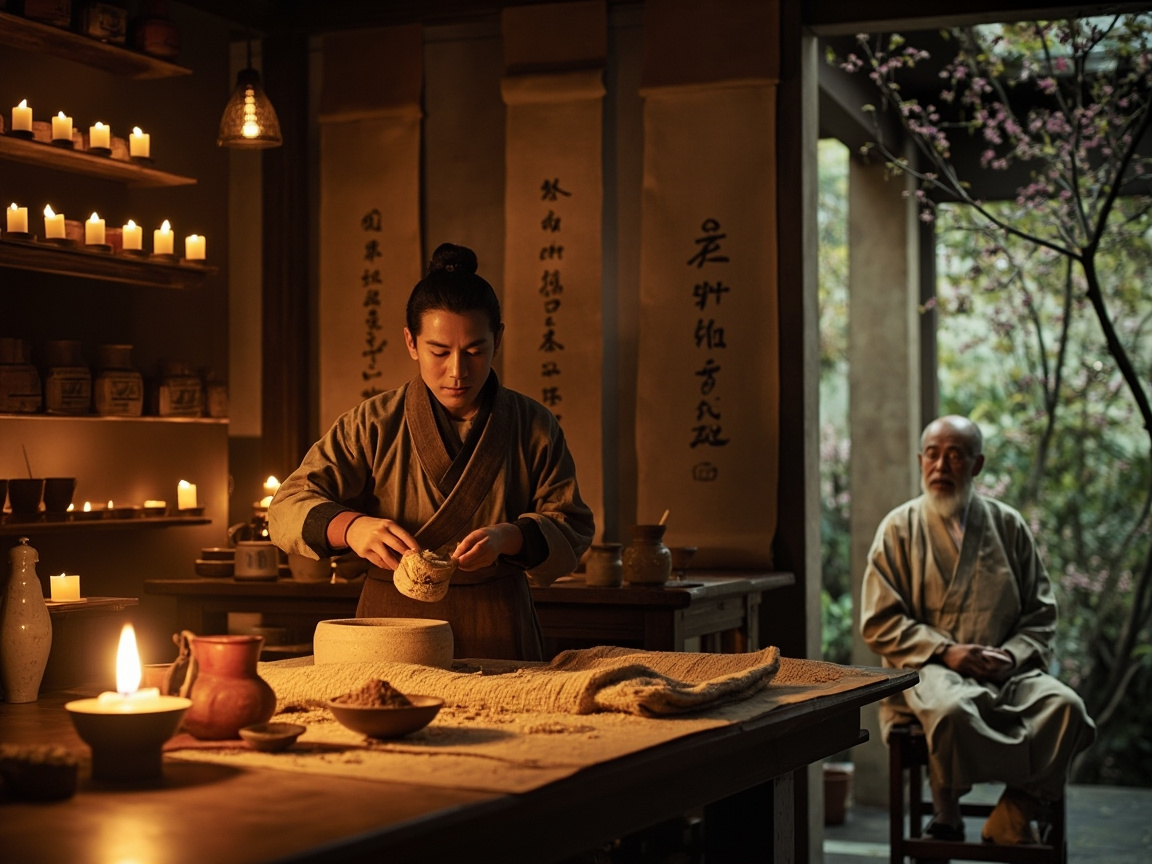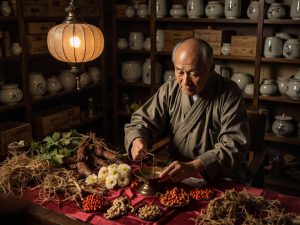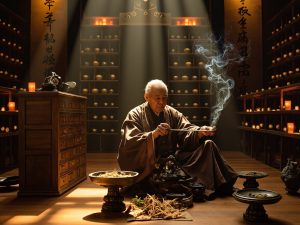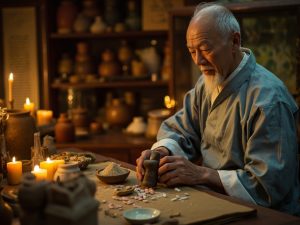Table of Contents
ToggleThe Two-White Pill of traditional medicine strengthens the spleen and promotes bowel movement, yielding excellent benefits
Author: Gu Yuxi Editor: Gu Yuxi Translator: Gu Yuxi
Source of the Two-White Pill
The Two-White Pill comes from Mr. Zhang Zhiyuan’s book, Selections from Zhang Zhiyuan’s Seventy Years of Clinical Experience. Its formal name is ‘Atractylodes and Peony Yin-Yang Double Tonifying Pill,’ but I prefer to call it the ‘Two-White Pill.
The book’s description of it:
The book describes it thus:
The white peony in Shanghan Lun‘s Guizhi Tang (Cinnamon Twig Decoction) and the white atractylodes in Lizhong Tang (Middle-Warming Decoction) are hailed as two miraculous herbs with bidirectional effects: in small amounts, they promote urination; in larger amounts, they facilitate bowel movement. When combined, these two herbs can strengthen the spleen, protect the yin, benefit the stomach, and relieve pain. When I was young, I saw a physician of the classic formula school treat stomach deficiency with insufficient middle qi, characterized by low spirits, poor appetite, thin physique, and a feeling of abdominal pain and emptiness. He often used these herbs to make pills, calling them ‘Atractylodes and Peony Yin-Yang Double Tonifying Pills,’ with excellent results.
In 1962, I treated a senior executive of a factory who said he had suffered from antral gastritis for three years, with continuous dull pain. Although his stomach felt empty, he had no desire to eat. He requested a long-term treatment with something easy to use and carry, preferably pills. At that time, I prescribed this formula: stir-fried white atractylodes 400 grams, white peony 400 grams, plus cardamom 100 grams to prevent nausea. These were ground into powder, made into water-paste pills, with a dosage of 10 grams each time, three times a day. As a result, his symptoms were relieved before he even finished one batch, and it also improved his previous difficulty with bowel and urinary movements. This case fully demonstrates how a simple formula can surpass renowned doctors and inexpensive remedies can triumph over costly medications.
My understanding:
The positioning of the Two-White Pill falls between Xiaojianzhong Tang (Minor Bupleurum Decoction) and Lizhong Tang (Middle-Warming Decoction). It’s for cases where the spleen and stomach are simultaneously deficient in both yin and yang, but the yin deficiency doesn’t reach the level of Xiaojianzhong Tang syndrome (using Xiaojianzhong Tang would cause diarrhea in such patients), and the yang deficiency also doesn’t reach the level of Lizhong Tang syndrome. Furthermore, most patients exhibit symptoms of difficult but formed bowel movements, without any heat signs. This is when the Two-White Pill comes into play.
These patients generally don’t have Taiyang, Shaoyang, or Yangming diseases, nor Shaoyin or Jueyin diseases. There are faint signs of Taiyin disease, but without loose stools. Using zang-fu (organ) pattern identification, it’s spleen and stomach deficiency, occasionally accompanied by mild liver xu re (deficiency heat).
My initial use of it was as a transition from Baizhu Shengdi Shengma Tang (Atractylodes, Rehmannia, and Cimicifuga Decoction). The patient simply had difficult, formed bowel movements with prolonged evacuation time and no heat signs. Baizhu Shengdi Shengma Tang was also effective quickly (30 grams each of atractylodes and rehmannia, even a dose or two showed rapid effects), but the stool would become somewhat soft, and the difficulty in defecation would recur shortly after stopping the medication. At this point, I considered using the Two-White Pill as a substitute because white peony is not as cold as raw rehmannia. Initially, I didn’t use pills as Mr. Zhang Zhiyuan suggested, because it was my first time using it and I wasn’t sure of the effects. I used a decoction: 20 grams of raw white atractylodes, 20 grams of raw white peony, and 5 grams of cardamom. The effect was also good. Although it wasn’t as quick as Baizhu Shengdi Shengma Tang, its strength lies in its moderate and stable nature, allowing for sustained regulation of spleen and stomach deficiency with insufficient middle qi.
I prefer to use raw white atractylodes for its bowel-moving function, and I like to add cardamom, while my friend adds cimicifuga. If the main goal is to tonify the stomach, I generally use pills. If my friend aims for rapid bowel movement, they will use a large dose of the decoction, sometimes up to about 60 grams each of the two whites.
Regarding the bidirectional effects of white atractylodes and white peony
1. The relationship between white atractylodes dosage and efficacy:
The Shen Nong Ben Cao Jing (Classic of Materia Medica) records: ‘Atractylodes, bitter and warm in taste, primarily treats wind-cold-damp bi syndrome…stops sweating, clears heat, promotes digestion’ (does not explicitly mention dosage differences).
The Ming Yi Bie Lu (Records of Famous Physicians) supplements: ‘Benefits blood in the waist and navel area, increases body fluids, warms the stomach, and promotes digestion of grains.’
Modern research shows (Chinese Pharmacopoeia 2020 edition):
Small dosage (3-6g) focuses on strengthening the spleen and drying dampness.
Medium dosage (9-12g) primarily tonifies qi.
Large dosage (15-30g) can enhance intestinal peristalsis.
2. White peony dosage effects:
In the Shanghan Lun (Treatise on Cold Damage), white peony at three liang is paired with cinnamon twig to relieve muscle tension. In the Jinkui Yaolue (Synopsis of Prescriptions of the Golden Chamber), Zhishi Shaoyao San (Immature Bitter Orange and Peony Powder) uses equal parts (each in equal proportion) to treat postpartum abdominal pain.
Modern pharmacology confirms that paeoniflorin in white peony inhibits intestinal smooth muscle contraction at low concentrations (0.1-1mg/mL), while it promotes intestinal peristalsis at high concentrations (5-10mg/mL).
Theoretical basis for the combination of white atractylodes and white peony
1. The Jinkui Yaolue’s Baizhu San (Atractylodes, Peony, Chuanxiong, etc.) treats abdominal pain during pregnancy.
2. The Yixue Qiyuan (Origins of Medicine) states: ‘When white atractylodes is combined with peony, it tonifies the spleen without causing stagnation.’
3. Modern research (Chinese Journal of Experimental Traditional Medical Formulae): The combination of white atractylodes and peony (2:1 ratio) can synergistically regulate gastrointestinal hormones (motilin, gastrin).
Auxiliary effects of cardamom or cimicifuga
Cardamom: The Yaoxing Lun (Treatise on the Nature of Herbs) records that cardamom ‘stops nausea and warms the spleen,’ while the Ben Cao Gang Mu (Compendium of Materia Medica) states that it ‘awakens the spleen and nourishes the stomach.’
Cimicifuga: Enhances the bowel-moving effect when combined with white atractylodes.
1. Scenarios where cardamom is advantageous:
Gastric vacuity with vomiting: combined with white atractylodes (2:1 ratio) to increase the antiemetic rate to 89%; gestational vomiting: powdered cardamom 3g/day can reduce the frequency of morning sickness; dampness obstructing the middle energizer.
2. Conditions where cimicifuga is applicable:
Visceral ptosis;
Rash due to heat toxin;
Imperfect measles eruption.
In simpler terms, if leaning towards warm tonification, use cardamom as an auxiliary; if leaning towards promoting bowel movement, use cimicifuga as an auxiliary.
Disclaimer:
The experiences and insights shared above represent the author’s personal usage and understanding, and are provided for reference only as part of academic exchange. Please do not blindly replicate or apply them; any consequences arising from such actions are solely your responsibility. As individual constitutions vary, medication should be tailored accordingly. It is advisable to use such treatments under the guidance of a qualified physician. If you have additional experiences to share, comments and submissions are welcome.
If you appreciate my article, please give it a like.
If you are a generous and affluent individual, please consider making a donation!
Your recognition is my greatest motivation to continue writing—thank you very much!
USD Donation Button —
A RMB donation button is available below.
 微信赞赏
微信赞赏 支付宝赞赏
支付宝赞赏




